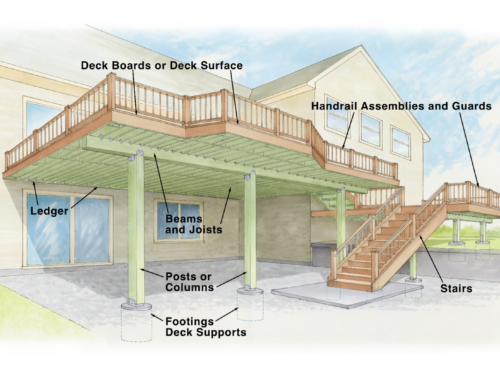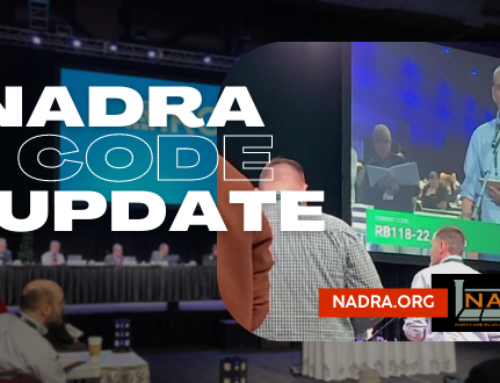By Glenn Mathewson
At the annual meeting in October, it was announced that I was prepared to work for NADRA and the decking industry to represent them in the development of the 2021 International Residential Code. I know it’s hard for most to wrap their heads around the idea of changing the 2018 code already, considering it doesn’t even have widespread adoption yet. That’s why you’ve hired me, and I’ve already gotten to work. The best place to begin that work was to contribute to the Deck Code Coalition, an unofficial coalition of the most powerful interests in deck code. Organizations such as the NAHB, SMA and AWC are involved. Code officials from multiple ICC chapters, product manufacturers, engineering firms, and many other professionals from various backgrounds are also there. Where is there? It’s an imaginary campfire with all interests sitting around together, sharing, talking, contributing, arguing at times, but yet no one has been thrown in the fire. This is how code should be developed, with the overall interest being the people…the end user. I believe the efforts thus far, thanks to those members that have financially contributed, have been more successful than I expected.
Here’s a run down of proposals likely to be submitted Jan. 7th with the combined support of nearly all the contributors of the Deck Code Coalition. I am proud of NADRA for being a part of this support.
Are you shocked by the new minimum14-inch diameter footing/pier required in the 2018 IRC? If you haven’t heard, even the four footings under that small stair landing must be 14 inch. We expressed our concerns of this to the DCC and the American Wood Council (AWC) agreed and re-engineered new minimum footing diameters for the table. How does a minimum 8-inch diameter sound for those little landing? Well, that’s what is being proposed and supported by the DCC. Had NADRA not expressed our concerns, no one was going to address it. The AWC deserves a big thank you for their engineering work.
The new beam, joist and post sizing tables first included in the 2015 IRC only handled regions with up to a 40 psf snow load. Through significant effort from the AWC, new larger tables have been engineered to handle snow loads of 50, 60 , and 70 psf. This new code, if included in the IRC, won’t help out for all regions, but for the snowier regions that were left with nothing but job-specific engineering, this provides a much more affordable design option.
Poorly written code is hard to understand, makes the industry it addresses look ignorant, and lends itself to inconsistent interpretation. Changes to the exceptions for footing sizes and frost protection were left pretty messy in the 2018 IRC. A proposal that reorganizes those provisions will make the code much easier to read and understand. While this may not seem like a big deal to many, rest assured, it’s worthwhile work.
Guards and handrails are like peanut butter and jelly, they are completely different, but often end up in the same sandwich. Guards along stairs may include a handrail feature at the top, or they may support a handrail at the side, but serve a different function and must resist different loads and load directions. The IRC has always lumped these two features together in the load table that specifies the load and load directions they must resist. With recent testing and validation for guard strength, manufacturers and others have published many details for how to build guards. NADRA has long stood that before work is done to design guards to resist the code-specified minimum loads, those loads should be re-evaluated. In my research of minimum guard loading over the last 5 decades, it’s clear to see that the target loads have been a “best guess”. After attending a meeting with the American Society of Civil Engineers (the authority on design loads) and supporting efforts by the NAHB, we are proud that a proposal to separate guards and handrails in the load table and address the direction of loading for guards more specifically will be submitted by the DCC in January.
On the same subject of guard loading, we have worked diligently to help other interests in deck code understand what we understand about guard design. It’s creative and unique and that’s what “the people” want. Reputable professionals have a strong motivation to see a specific guard post connection detail illustration with proprietary hardware devices in the pages of the IRC. The intent is good natured and understandable. Inspectors have long had nothing but a push on guards as their measure of code compliance (safety), and that can leave anyone with that responsibility a little uneasy. They too see the news of the failing decks across our country. This is respectable and understandable. However, builders are equally uneasy about another “picture” being put in the code that appears to universally require proprietary hardware and a specific method for post attachment. Remember the lateral load anchor? How can you forget? It’s false flag and illusion of a complete lateral load design have forever changed the industry, and still today, 10 years later, it’s only “permitted” not “required”. A picture is worth a thousand words, and for many inspectors there’s no need to read the permissive words if the seemingly required picture is there. We can’t see this happen to guards the same way it happened to ledgers.
The will to address poorly built deck guards in the IRC is strong and has made two attempts at guard structural design code in the last two editions. To do this work respectably, no one should have everything their way. While NADRA has incredible experience with boots on the ground, we don’t know it all. If we appreciate the experience from other professionals when we agree, then we must also respect their experiences when we disagree. With this humble philosophy comes respectable code. Code that was carried to the hearings in many loving arms is far greater than code pushed in with singular, selfish power. Compromise has to be made by all, so NADRA took the first step. To respect the concerns of others and hope they return it with respect for ours, we entertained new code language to prohibit some of the notoriously insufficient guard designs. Minimum 4×4 posts for guards will eliminate some shoddy 2×4 posts that can be found. Notching of 4×4 posts in guard construction has been done for all of time, and though it works in some rare cases, it generally does not. Research has been done on this subject, and the proof is pretty clear. To help show our willingness to address this common mode of guard failure, NADRA has thus far agreed to support a prohibition of notching 4×4 guard posts. Other proposed code language includes clear instruction that the guard posts must be secured to adjacent joists and transfer the loads into the whole deck, not just the rim joist. We were careful this language didn’t specify “blocking” that could interfere with deck drainage systems. We also made sure to exclude any mention of proprietary hardware.
It was our hope that by taking the first step to compromise and draft code language to address guard safety we would encourage others of the same teamwork and they would withdrawal their proposal for a “picture”. Unfortunately…we were unsuccessful. Though the DCC was able to agree on 6 proposals, including the one we compromised in, select members have announced they will still propose the “picture” and we must battle it out at the hearings. To say I’m disappointed is an understatement, and to say I didn’t lose a little respect for those professionals would be a lie. The code must represent all professional experiences and be the best mix of them all. Period. The professionals contributing to the DCC bring enough experience and spent enough time sharing it together, that any proposal that could not be agreed upon by all, is a proposal unfit for the hearing and for the code. Period. No exceptions. In bringing the voice of the decking industry to the code development process, we must do it with as much respect and understanding as possible, and we can only hope to receive it in return. Alas, NADRA will need to take that message to the hearing and be sure the attendance knows that the guard picture proposed next year is lacking the support of many professionals.
Now for the bad news… Helping with these 6 proposals is only a slice of the work to be done. They are simply the proposals we could contribute to before the hearings. On January 7th of next year, thousands of pages of proposals will be submitted and they will likely contain many deck-related proposals we have yet to know anything about. NADRA must be prepared to comb through these proposals when they are published in March. I’ve heard some rumors of two proposals to expect. One to require the same additional load on deck boards that stair treads must resist. Notice how with most plastic composite lumber you can’t span as far on stair treads as you can for deck boards? A max 16-inch span for decking is often reduced to 12 inches on stairs, but not if that proposal wins. Of course every single max span you have come to know could change with this next one. A proposal from a powerful proponent is likely to be submitted, one that would raise the minimum design live load of 40 psf to 60 psf, but just for decks. Not the floor inside the house.
Did you hear those last two? Ready to change all your design norms? Ready to retest all your manufactured decking? Are you ready for singular powers that don’t manufacture, sell, or build decks to tell you how to do it? When was the last time you had a deck built to 40 psf collapse under load? Not due to some construction flaw.
These last few months of 2018 have proven the necessity for NADRA to have funding to represent the industry in code, but the work has hardly begun. Much is still needed of the membership if NADRA is to continue contributing to this work. Your help is needed.
To support NADRA’s important Code initiative, please visit and share our code fundraising page and consider contributing today.
Thank you for your support!




